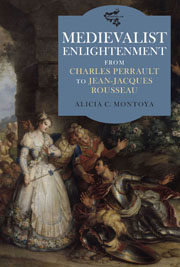Book contents
- Frontmatter
- Contents
- Dedication
- Acknowledgments
- Introduction
- I CONCEPTUALIZING THE MEDIEVAL
- II REIMAGINING THE MEDIEVAL
- 3 Survivals: Reading the Medieval Roman at the Dawn of the Enlightenment
- 4 Continuities: The Medieval as Performance
- 5 Reconfigurations: Medievalism and Desire, Between Eros and Agape
- III STUDYING THE MEDIEVAL
- Conclusion: Medievalism as an Alternative Modernity
- Bibliography
- Index
3 - Survivals: Reading the Medieval Roman at the Dawn of the Enlightenment
from II - REIMAGINING THE MEDIEVAL
Published online by Cambridge University Press: 05 May 2013
- Frontmatter
- Contents
- Dedication
- Acknowledgments
- Introduction
- I CONCEPTUALIZING THE MEDIEVAL
- II REIMAGINING THE MEDIEVAL
- 3 Survivals: Reading the Medieval Roman at the Dawn of the Enlightenment
- 4 Continuities: The Medieval as Performance
- 5 Reconfigurations: Medievalism and Desire, Between Eros and Agape
- III STUDYING THE MEDIEVAL
- Conclusion: Medievalism as an Alternative Modernity
- Bibliography
- Index
Summary
Understanding the medieval as essentially a moral-literary concept, late seventeenth– and early eighteenth-century readers perceived it to be exemplified above all by one genre: the roman. In contrast to ecclesiastic historians and antiquaries who, like Mabillon, worked on charters, registers and capitularies that they did not explicitly designate as medieval, it was to the roman that most other, non-professional or semi-professional readers turned when speaking of this period. Chapelain derived his arguments in favour of a reassessment of the medieval from his reading of the thirteenth-century Lancelot. Likewise, when commenting on the particularly French spirit of gallantry (esprit de galanterie) in his Esprit des Lois, even the immensely learned magistrate Montesquieu referred to practices described not in historical documents, but in popular chivalric fiction. That roman was often synonymous with “medieval” was signalled by the first edition of the Dictionnaire de l'Académie française (1696), when it listed as examples of the term's usage “Old romans (les vieux romans). Modern romans. The roman of Lancelot du Lac, of Perceforest. The roman de la Rose. The roman of Amadis. A new roman. The roman of Astrée, of Polexandre, of Cyrus, of Cassandre”
But if the medieval was invariably defined in relation to the genre of the roman, then what did this imply for the way that readers approached real examples of medieval narrative fiction? This chapter will explore how, during the early period covering the 1680s to the 1700s, the roman or chivalric romance (roman de chevalerie) was read by contemporary readers, and how these readings related to other conceptualizations of the medieval. This is a vast subject, and one on which much basic research in book history needs still to be carried out before a synthetic overview is possible.
- Type
- Chapter
- Information
- Medievalist EnlightenmentFrom Charles Perrault to Jean-Jacques Rousseau, pp. 71 - 106Publisher: Boydell & BrewerPrint publication year: 2013



